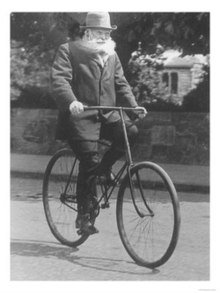John Boyd Dunlop, who was born in Dreghorn, North Ayreshire, on February 5, 1840, exactly 165 years ago today, joined a long list of other brilliant Scottish inventors by developing the pneumatic tire.
A Scottish-born inventor and veterinarian who spent the majority of his career in Ireland was John Boyd Dunlop (5 February 1840 – 23 October 1921). He was skilled at creating rubber gadgets, so he created the first useful pneumatic tyres for his child’s tricycle and later improved them for use in cycle racing. To a company he co-founded with Harvey Du Cros, the head of the Irish Cyclists’ Association, he transferred his rights to the pneumatic tyres in exchange for a small cash payment and a minor stake in their pneumatic tyre company. At the end of 1896, Dunlop left. Dunlop Pneumatic Tyre Company, the business that carried his name, was actually Du Cros’s invention; nevertheless, it wasn’t until much later that it was established under its well-known brand name.
He was raised on a farm in Dreghorn, North Ayrshire. He attended the Dick Vet at the University of Edinburgh to become a veterinarian before relocating to Downpatrick, Ireland, in 1867.
He learned he was born two months earlier than his mother had anticipated, at a very young age. He lived believing his health was precarious and acting accordingly, but he never experienced a significant sickness until he suddenly passed away at the age of 81 from a chill in October 1921. He was described by Sir Arthur Du Cros as a reserved, polite man who was still confident in his talents.
In 1871, he wed Margaret Stevenson, and the two of them produced a son and a daughter. Together with his brother James Dunlop, he founded the Downe Veterinary Clinic in Downpatrick before relocating to 38-42 May Street in Belfast, where by the middle of the 1880s, it had grown to become one of the biggest operations in Ireland.
For his son’s tricycle, Dunlop invented pneumatic tires, which he soon had manufactured commercially in Scotland. A cyclist who started exploiting his tyres to win races caught Harvey Du Cros’ notice. Dunlop exchanged a little portion of the new company he was starting with Du Cros for some cash. Together with Du Cros, he surmounted several obstacles that their company faced, including the loss of his intellectual rights. He relocated to Dublin soon after Harvey Du Cros successfully refloated Booth Bros of Dublin as the Pneumatic Tyre and Booth’s Cycle Agency in 1892, when he retired from his veterinary practice. When J. K. Starley’s safety bicycle was introduced in 1885, the bicycle industry had a boom that continued until the invention of the pneumatic tire.
J B Dunlop sold out in 1895 and took no further interest in the tyre or rubber business. His remaining business interest was a local drapery.

Pneumatic tyres
For his son’s tricycle in October 1887, John Boyd Dunlop created the first practical pneumatic or inflatable tire. Using his expertise with rubber, he attached it to a wooden disc measuring 96 centimeters in diameter in the yard of his Belfast home. An inflated tube of sheet rubber served as the tyre. He then rolled both his wheel and a metal wheel off of his son’s tricycle across the yard. The pneumatic wheel kept moving while the metal wheel came to a stop before colliding with a gatepost and rebounding. Dunlop then installed pneumatics on the tricycle’s two rear wheels. With even more astounding findings, Dunlop switched to larger tires for a bicycle after that too performed better. He put it to the test on Cherryvale Sports Ground in South Belfast, and on December 7th, 1888, a patent was issued. Dunlop was unaware that Robert William Thomson of Stonehaven, another Scot, had filed a patent for a pneumatic tire in 1847.
Willie Hume demonstrated the supremacy of Dunlop’s tyres in 1889, winning the tyre’s first-ever races in Ireland and then England. The captain of the Belfast Cruisers Cycling Club, he became the first member of the public to purchase a bicycle fitted with pneumatic tyres, so Dunlop suggested he should use them in a race. On 18 May 1889 Hume won all four cycling events at the Queen’s College Sports in Belfast, and a short while later in Liverpool, won all but one of the cycling events. Among the losers were sons of the president of the Irish Cyclists’ Association, Harvey Du Cros. Seeing an opportunity, Du Cros built a personal association with J B Dunlop, and together they set up a company which acquired his rights to his patent.
Dunlop was officially informed two years after receiving the patent that it was invalid because the invention had already been patented in 1846 in France and 1847 in the US by Scottish scientist Robert William Thomson (1822-1873). tire (see) Dunlop and Du Cros revived a Dublin-listed firm and renamed it Pneumatic Tyre and Booth’s Cycle Agency in order to profit from pneumatic bicycle tires. Dunlop stopped working in 1895. Du Cros sold their whole bicycle tire company to British investor Terah Hooley in 1896 for $3 million. Hooley resold the business to the public for £5 million after setting up some new window-dressing, titling board members, etc. Up until his passing, Du Cros maintained control of the company. It was called Dunlop Rubber in the beginning of the 20th century.
Dunlop’s pneumatic tyre arrived at a critical juncture in the evolution of road transportation, despite the fact that he did not participate beyond 1895. In Belfast, he started making cycle tires for sale in late 1890, but it wasn’t until well after his retirement in 1900 that he started making vehicle tires. J. B. Dunlop’s idea did not bring him a large wealth.

